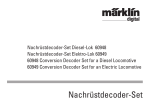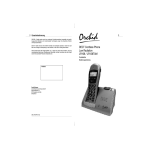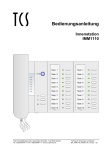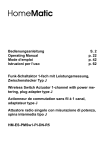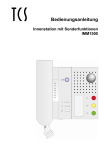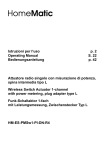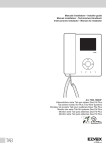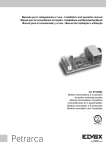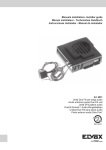Download HT 4500 - SKS
Transcript
HT 4500 Version 1.2 ~1~ 1. Installation Gefahr für Personen durch einen elektrischen Schlag. Verbrennungsgefahr, Geräteschäden und Fehlfunktionen. Bei der Installation sind die Richtlinien der VDE 0100 und VDE 0800 einzuhalten. (Deutschland) Gegenmaßnahmen: Schalten Sie zu Beginn der Arbeiten alle Spannungsführenden Leitungen frei. Sichern Sie die ausgeschalteten Leitungen gegen irrtümliches Wiedereinschalten. Stellen Sie Spannungsfreiheit durch Messung fest. Decken Sie benachbarte, unter Spannung stehende, oder leitfähige Teile ab. Alle Arbeiten und elektrische Anschlüsse müssen den nationalen Bestimmungen des jeweiligen Landes entsprechen und von entsprechend ausgebildetem Fachpersonal durchgeführt werden. Bei Geräten mit 230-V-Anschluss ist die DIN VDE 0100 zu beachten und einzuhalten. 2. Klemmenbezeichnung Klemme Bezeichnung a BUS-Klemme b BUS-Klemme E+ Etagenklingel E- Etagenklingel ~2~ 3. Programmierung Nur für Sonderfunktionen 3.1 Programmierung von nur einer Rufadresse (ein Klingeltaster für eine Sprechstelle) Nach der im Anhang befindlichen SKS-BUS Rufadressen Tabelle die gewünschte Rufadresse des Gerätes am DIP-Schalter einstellen. Jede Rufadresse ist fest einem Klingeltaster in der Türstation zugeordnet. Die Rufadressenverteilung ist bei SKS Türstationen in der Türstation oder am Türlautsprecher 4503, 4508 oder 4808 hinterlegt. 3.2 Programmierung von bis zu 4 Rufadressen (2...4 Klingeltaster für eine Sprechstelle oder Internsprechen) Die Sprechstelle kann bis zu 4 SKS-BUS Rufadressen für Hausruf-, Internrufadressen oder Gruppenrufadressen speichern. Die erste Adresse ist dann die Hauptadresse, die als eigene Gerätekennung übermittelt wird. Auf die bis zu 3 weiteren Rufadressen reagiert die Sprechstelle bei eingehenden Hausrufen (Klingeltasten der Türstation), Internrufen (Sprechen zwischen zwei Innensprechstellen) und Gruppenruf (Sprechen von einer Innensprechstelle mit einer von bis zu 4 Innensprechstellen). Hinweis: Bei Sprechstellen mit Ruftonabschaltung muss während der Programmierung der Rufton eingeschaltet sein. Arbeitsschritt 1 2 3 4 Beschreibung Die Rufadresse am DIP-Schalter einstellen. Die 1. Rufadresse ist der Hausruf (Klingeltaste an der Türstation). Die Programmiertaste für ca. 5 Sekunden drücken bis der erste Kontrollton ertönt. Nach diesem Kontrollton ertönt ein kurzer Ton. Er signalisiert, dass die erste Rufadresse programmiert ist. Die Anzahl der kurzen Töne signalisieren auf welchem Speicherplatz die Rufadresse gespeichert wurde. Zum Programmieren weiterer Rufadressen wiederholen Sie die Schritte 1 bis 3. Es können maximal 4 Rufadressen gespeichert werden. Sollen Rufadressen geändert werden, müssen zuvor wie unter 3.3 beschrieben, alle Rufadressen gelöscht werden. Hinweis: Nach Abschluss der Programmierung den DIP-Schalter wieder auf die Hauptadresse einstellen, damit eine leichtere Zuordnung der Klingeltaste zur Sprechstelle im Fehlerfall möglich ist. 3.3 Löschen aller Rufadressen Es können keine einzelnen Rufadressen gelöscht werden. Es werden immer alle Rufadressen gelöscht. Halten Sie die Programmtaste für ca. 25 Sekunden gedrückt. Während dessen sind mehrere Kontrolltöne zu hören. Die Löschung ist abgeschlossen, wenn ein 3 Sekunden langer hoher Signalton ertönt. Lassen Sie jetzt die Programmtaste los. Alle Rufadressen sind jetzt gelöscht. Hinweis: Nach dem Löschen der Einprogrammierten Rufadressen ist nur die Adresse, welche am DIPSchalter eingestellt ist wirksam wie unter 3.1 beschrieben. ~3~ 4. Bedienungsanleitung Funktion Tasten Rufton Ein-/Ausschalten Wurde das Gerät angeklingelt, kann innerhalb von 2,5 Minuten mit der Türöffnertaste die Tür geöffnet werden. Tür öffnen Die Automatische Türöffnung ist nur mit den Modellen HT4500-x-MS-ATÖ möglich. Diese Sprechstellen haben einen Schiebeschalter unter den Tasten. Stellen Sie den Schiebeschalter auf „OFF“ um die Automatische Türöffnung einzuschalten. Der Rufton ist dann ausgeschaltet. Automatische Türöffnung Hausrufklingelton ändern Etagenrufklingelton ändern + + Die Tontaste gedrückt halten und anschließend die Türöffnertaste innerhalb von 2 Sekunden kurz drücken. Mit jedem Tastendruck der Türöffnertaste erklingt eine andere Melodie. Wird die gewünschte Melodie abgespielt, lassen Sie beide Tasten los. Es stehen 8 verschiedene Kingeltöne zur Auswahl. Die Tontaste gedrückt halten und anschließend die Türöffnertaste innerhalb von 2 Sekunden drücken und beide gedrückt halten. Warten Sie bis die gewünschte Melodie ertönt. Lassen Sie beide Tasten los. Es stehen 4 verschiedene Etagenruftöne zur Auswahl. Die Tontaste gedrückt halten, bis die gewünschte Lautstärke erreicht ist. Die Lautstärke ist 5-stufig einstellbar. Klingellautstärke ändern Licht- und Sondertaste Vorgehensweise Nehmen Sie nachdem das Gerät angeklingelt wurde den Hörer ab. Eine Rufabschaltung ist nur bei den Modellen HT4500-x-MS möglich. Diese Sprechstellen haben einen Schiebeschalter unter den Tasten. Stellen Sie den Schiebeschalter auf „OFF“ um den Rufton abzuschalten. Um den Rufton einzuschalten, stellen Sie den Schiebeschalter auf „ON“. Gespräch annehmen + Nur bei HT4500-4 Die Sondertaste „S“ wird standardmäßig mithilfe eines Schaltaktors 4507 zum Schalten verwendet. Des Weiteren wird durch betätigen der Lichttaste ein interner potentialfreier Kontakt auf der Sprechstelle geschlossen. Die Lichttaste kann optional auch zum Schalten des Schaltaktors verwendet werden. Bitte bei Bestellung angeben. ~4~ 5. Technische Daten Elektrische Daten Spannung a / b 19 – 23VDC Allgemeines Umgebungstemperatur -10°C bis +45°C Feuchtigkeit 20% bis 90% nicht kondensierend Gehäuse Kunststoffgehäuse Abmessungen (Breite x Höhe x Tiefe) 89 x 230 x 58 mm ~5~ ~6~ 1. Installation Hazard of electrical strike and burns to persons, as well as damage of equipment and malfunctions . Observe VDE 0100 and VDE 0800 guidelines during installation. (Germany) Countermeasures: Before beginning any work, deactivate and disconnect all energized electrical wires. Secure the switched off/ disconnected lines against erreneous reconnection. Use a measuring device to make sure that the wires are deenergized. Cover up any adjacent, energized or conducting components. All work and all electrical connections must comply with the national provisions for the country in question and must be performed by appropriately trained personnel DIN VDE 0100 must be observed and complied with in devices with a 230V connection 2. Terminal Designation Terminal Designation a BUS-Terminal b BUS-Terminal E+ Floor bell E- Floor bell ~7~ 3. Programming DIP switch programming key For special function only 3.1 Programming Only One Call Address (One Call Button for One Intercom Unit) Set the desired call address for the device on the DIP-Switch following the SKS-BUS Address Table in the appendix. Each call address is assigned to one call button in the door station. The call address distribution is stored in the door station or in the door speaker 4503, 4508 or 4808. 3.2 Programming up to 4 Call Addresses (2...4 Call buttons for an Intercom Unit or Internal Call Units) The intercom unit can store up to 4 SKS-BUS call addresses for house call, internal call or group call addresses. The first address is the main address and is transmitted as the device identification. The intercom unit will respond to up to 3 additional call addresses for incoming house calls (call button for the door station), internal calls (talking between two intercom units) and group calls (talking between one intercom unit and up to 4 other intercom units). Note: With intercom unit that can mute the ringer, the ringer must be turned on during programming. Step 1 2 3 4 Description Set the call address on the DIP-Switch. The 1st call address is the house call (call button on the door station). Push the programming button for about 5 seconds until you hear the control tone. After this control tone sounds you will hear a short tone that signals that the first call address has been programmed. The number of short tones indicates the memory location at which the call address was stored. To program additional call addresses, repeat steps 1 to 3. A maximum of 4 call addresses can be stored. If call addresses need to be changed, all call addresses must first be deleted, as described under 3.3. Note: After programming is finished, set the DIP-Switch to the main address again so that it is possible o to assign the button to the intercom in the case of a fault. 3.3 Delete All Call Addresses Call addresses can not be deleted individually. All addresses are deleted every time. Hold the programming button down for around 25 seconds. While you are doing this, you will hear several control tones. Deletion is completed when you hear a 3-second-long high-pitched signal tone. Now release the programming button. All call addresses have been deleted. Note: After you have deleted the programmed call addresses, only the address set on the DIP-Switch is in effect, as described under 3.1. ~8~ 4. Operating Instructions Function Button Procedure Turn ringer on/off Pick up the receiver after the unit has been rung. You can only turn off the ringer on models HT4500-x-MS. These intercoms have slider switch above the button. Push the slider switch to “OFF” to turn off the ringer. To turn the ringer back on, set the slider switch to “ON”. Open door If the device is rung, the door can be opened within 2.5 minutes using the open door button. Automatic door opening Automatic door opening is only possible on models HT4500-x-MS-ATÖ. These intercom units have a slider switch under the button. Set the slider switch to “OFF” to activate automatic door opening. The ringer is turned off. Accept call Push the sound button and then quickly push the open door button within 2 seconds. A different tune will sound with each push of the button. When the desired tune plays, release both buttons. 8 different buttons are available. Change house call tune Change floor call tune + + Push the sound button until the desired volume is reached. There are five different sound settings to select from. Change ring volume Light and special button Push the sound button and then quickly push the open door button within 2 seconds. A different tune will sound with each push of the button. Wait until the desired tune plays, then release both buttons. There are 4 different floor call tunes. + Only on the HT4500-4. The special button “S” is used standard for switching in combination with a switching actuator 4507. Furthermore, pressing the light button closes an internal potential-free contact at the intercom unit. The light button can be used optionally to switch the switching actuator. Please indicate if you want to use this option when ordering. ~9~ 5. Technical Data Electrical Data Voltage a / b 19 – 23VDC General Ambient temperature -10°C to +45°C Humidity 20% to 90% non-condensing Housing Plastic housing Dimensions (width x height x depth) 89 x 230 x 58mm ~ 10 ~ ~ 11 ~ 1. Installation Danger d'électrocution pour les personnes. Risque de brûlure, de dommages à l’appareil et de dysfonctionnements. Les directives de la VDE 0100 et de la VDE 0800 doivent être respectées lors de l’installation. (Allemagne) Contre-mesures : Mettez hors tension toutes les lignes conductrices au début des travaux. Sécurisez les lignes déconnectées de manière à empêcher toute remise sous tension accidentelle. Constatez l’absence de tension en procédant à une mesure. Recouvrez les éléments voisins sous tension ou conducteurs. Tous les travaux et les connexions électriques doivent répondre aux dispositions nationales du pays concerné et sont l’affaire de spécialistes dûment qualifiés. La norme DIN VDE 0100 est à observer et à respecter pour les appareils connectés en 230 V. 2. Désignation des bornes Borne Désignation a Borne de bus b Borne de bus E+ Sonnerie d’étage E- Sonnerie d’étage ~ 12 ~ 3. Programmation micro interrupteurs DIP Touche programmation Pour fonctions spéciales uniquement 3.1 Programmation d’une seule adresse d’appel (un bouton de sonnette pour un carillon sur bus) D’après le tableau des adresses d’appel sur le bus SKS situés den annexe, définir l'adresse d'appel de l’appareil sur l'interrupteur DIP. Chaque adresse d’appel est dédiée à un bouton de sonnerie dans la station de porte. La répartition des adresses d'appel est enregistrée sur les stations de porte SKS ou sur le haut parleur 4503 pou 4508 ou 4808. 3.2 Programmation de 4 adresses d’appel au total (2 à 4 boutons de sonnette pour un poste ou la communication interne) Le poste peut enregistrer jusqu’à 4 adresses d'appel sur le bus SKS pour les adresses d’appels externes, internes ou les adresses d’appel de groupe. La première adresse est alors l'adresse principale transmise comme identification de matériel interne. Le poste d’interphone réagit aux 3 autres adresses d'appel pour les postes entrants (boutons de sonnette de la station de porte), appels internes (parler entre deux postes internes) et appel de groupe (converser depuis un poste de groupe (converser depuis un poste interne avec l'un des trois postes internes) Remarque : Pour les postes avec fonction Silence, la sonnerie doit être activée pendant la programmation. Phase de travail Description ère 1 2 3 4 Définir l’adresse d’appel sur l'interrupteur DIP La 1 adresse est d’appel extérieur (touche de sonnerie sur la station de porte). Appuyer environ. 5 secondes sur le bouton de programmation jusqu’à ce que la tonalité de contrôle retentisse. Après cette tonalité de contrôle, une brève tonalité signale que la première adresse d’appel est programmée. Le nombre de brèves tonalités signale sur quel emplacement de mémoire l’adresse d'appel a été enregistrée. Répétez les étapes de 1 à 3 pour programmer d’autres adresses d’appel. Au maximum, il est possible de mémoriser 4 adresses d’appel. Si les adresses d’appel sont modifiées, il faut d'abord supprimer toutes les adresses d'appel comme décrit sous 3.3. Remarque : Après la fin de la programmation, paramétrer de nouveau l'interrupteur DIP sur l’adresse principale afin de permettre une attribution plus simple de la touche de sonnerie au poste en cas de défaut. 3.3 Supprimer toutes les adresses d’appel. Il est impossible de supprimer des adresses d’appels individuelles. Toutes ces adresses doivent être supprimées. Maintenez la touche programme pendant environ 25 secondes. Plusieurs tonalités de contrôle retentissent pendant cette opération. La suppression s’achève lorsqu’une longue tonalité aiguë de signalisation de 3 secondes retentit. Relâchez à présent la touche programme. Toutes des adresses d’appel sont désormais supprimées. Remarque : Après la suppression des adresses d’appel programmées, seule l’adresse définie sur l’interrupteur DIP est active comme décrit sous le point 3.1. ~ 13 ~ 4. Mode d'emploi Fonction Touches Procédure à suivre Activer/désactiver la sonnerie Après sonnerie sur l’appareil, décrochez le combiné. La fonction silence n’est possible que sur les modèles HT4500-x-MS. Ces postes disposent d’un bouton poussoir sous les touches. Positionner le bouton poussoir sur "OFF“ pour neutraliser la sonnerie. Pour activer la sonnerie, positionner le bouton poussoir sur « ON ». Ouvrir la porte Si l'appareil sonne, il est possible d'ouvrir la porte en l’espace de 2.5 minutes à l’aide de la gâche d'ouverture. Ouverture de porte automatique L’ouverture de porte automatique n’est possible que sur les modèles HT4500-x-MS-ATÖ. Ces postes disposent d’un bouton poussoir sous les touches. Positionner le bouton poussoir sur "OFF“ activer l'ouverture de porte automatique. La tonalité d’appel est désactivée. Accueillir l’appel Changer la tonalité de sonnerie extérieure Changer la tonalité d’appel à l’étage + + Maintenez appuyée la touche son puis pressez brièvement pendant 2 secondes la gâche d’ouverture de porte.et maintenez les toutes deux enfoncées. Attendez que la mélodie souhaitée retentisse. Relâchez les deux touches. On peut choisir entre 4 différentes tonalités de sonneries à l'étage. Maintenir appuyée la touche son jusqu’à ce que le volume voulu soit obtenu. Le volume a 5 positions de réglage. Changer le volume de la sonnerie Touche éclairage et spéciale Maintenez enfoncée la touche son puis appuyez brièvement pendant 2 secondes la gâche d’ouverture de porte. Une sonnerie différente retentit à chaque pression de touche. Une fois la mélodie souhaitée exécutée, relâchez les deux touches. On peut choisir entre 8 tonalités de sonneries + Seulement sur HT4500-4 : La touche „S“ est utilisée par défaut pour la commutation à l’aide d’un actionneur 4507/ De plus, un contact sans potentiel interne est fermé sur le poste en actionnant la touche éclairage. La touche éclairage peut être utilisée en option pour commuter l'actionneur. Veuillez le préciser à la commande. ~ 14 ~ 5. Caractéristiques techniques Caractéristiques électriques Tension a / b 19 – 23VDC Généralités Température ambiante de -10°C à +45°C Humidité 20% à 90% sans condensation Boîtier Boîtier plastique Dimensions (largeur x hauteur x profondeur) 89 x 230 x 58mm ~ 15 ~ ~ 16 ~ Standard address range Extended address range DIP-Switch settings for intercoms, switch actuator and TK-Adapter Anhang, Appendix, Annexe ~ 17 ~


















